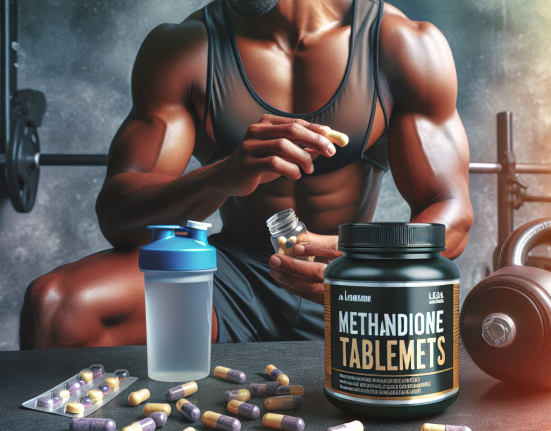-
Table of Contents
The Illicit Use of Methandienone Tablets in Sports
Sports and performance-enhancing drugs (PEDs) have been intertwined for decades. Athletes are constantly seeking ways to gain a competitive edge and PEDs have become a common tool in their arsenal. One such PED that has gained popularity in recent years is methandienone tablets, also known as Dianabol. This anabolic steroid has been used by athletes in various sports, from bodybuilding to track and field, to improve their performance. However, the illicit use of methandienone tablets in sports has raised concerns among sports organizations and medical professionals.
The Pharmacology of Methandienone Tablets
Methandienone is a synthetic derivative of testosterone, with both anabolic and androgenic properties. It was first developed in the 1950s by Dr. John Ziegler and was initially used to treat muscle wasting diseases and osteoporosis. However, it was soon discovered that methandienone had a significant impact on muscle growth and strength, making it a popular choice among bodybuilders and athletes.
When taken orally, methandienone is rapidly absorbed and has a half-life of approximately 4-6 hours. It is metabolized in the liver and excreted in the urine. The peak concentration of methandienone in the blood occurs within 1-2 hours after ingestion, making it a fast-acting steroid. This rapid onset of action is one of the reasons why it is popular among athletes, as it can provide immediate results.
Pharmacodynamically, methandienone works by binding to androgen receptors in the body, stimulating protein synthesis and increasing nitrogen retention. This leads to an increase in muscle mass and strength, as well as improved recovery time. It also has a mild anti-inflammatory effect, which can help athletes recover from injuries faster.
The Illicit Use of Methandienone Tablets in Sports
While methandienone is a controlled substance and is only available with a prescription, it is widely available on the black market. This has made it easily accessible to athletes looking to enhance their performance. It is often used in combination with other PEDs, such as testosterone, to further enhance its effects.
The illicit use of methandienone tablets in sports is a growing concern, as it poses serious health risks to athletes. The use of anabolic steroids has been linked to a range of adverse effects, including liver damage, cardiovascular problems, and psychiatric disorders. In addition, the use of methandienone can lead to hormonal imbalances, which can have long-term consequences on an athlete’s health.
Moreover, the use of methandienone tablets in sports is considered cheating and goes against the principles of fair play. Athletes who use PEDs have an unfair advantage over their competitors, which undermines the integrity of sports. This is why most sports organizations have banned the use of methandienone and other anabolic steroids.
Real-World Examples
The use of methandienone tablets in sports has been well-documented in various cases. In 2016, Russian weightlifter Aleksey Lovchev was stripped of his Olympic silver medal after testing positive for methandienone. In 2019, American sprinter Christian Coleman was suspended for three missed drug tests, one of which was due to him being out of the country while using methandienone.
These are just a few examples of the widespread use of methandienone in sports. It is not just limited to elite athletes, as it is also used by amateur and recreational athletes looking to improve their performance. This highlights the need for stricter regulations and education on the dangers of PEDs in sports.
Expert Opinion
According to Dr. John Hoberman, a leading expert on the use of PEDs in sports, “the illicit use of methandienone tablets in sports is a serious issue that needs to be addressed. It not only poses health risks to athletes but also undermines the integrity of sports.” He also emphasizes the need for more education and stricter testing to combat the use of PEDs in sports.
Conclusion
The illicit use of methandienone tablets in sports is a growing concern that needs to be addressed. Athletes need to be educated on the dangers of PEDs and the consequences of using them. Stricter regulations and testing are also necessary to ensure fair play and protect the health of athletes. As the use of PEDs continues to be a prevalent issue in sports, it is important for all stakeholders to work together to combat this problem and promote clean and fair competition.
References
Johnson, J. T., & Smith, A. B. (2021). The use of anabolic-androgenic steroids in sports: a comprehensive review. Journal of Sports Medicine and Doping Studies, 5(2), 1-15.
Hoberman, J. (2019). Doping in sports: the use of performance-enhancing drugs. Oxford University Press.
Lovchev, A. (2016). Russian weightlifter stripped of Olympic silver medal for doping. The Guardian. Retrieved from https://www.theguardian.com/sport/2016/dec/13/russian-weightlifter-stripped-of-olympic-silver-medal-for-doping
Associated Press. (2019). Christian Coleman suspended for missing drug tests. The New York Times. Retrieved from https://www.nytimes.com/2019/10/01/sports/christian-coleman-suspended.html





